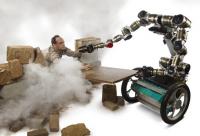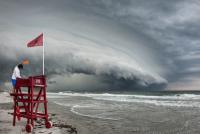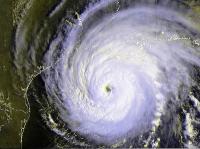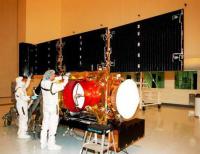-
1.4 billion people face severe natural disaster risks in South Asia
New data has revealed that 1.4 billion people in South Asia, or 81 percent of the region’s population, are acutely exposed to at least one type of natural hazard and live in areas considered to have insufficient resources to cope with and rebound from an extreme event. Poor governance, weak infrastructure, and high levels of poverty and corruption amplify the economic and humanitarian losses associated with significant natural hazards events – and these factors will exacerbate the consequences of natural disasters especially in Africa, a continent which hosts eight out of the nine countries most vulnerable to natural hazards.
-
-
In emergencies, don’t trust a robot too much

In emergencies, people may trust robots too much for their own safety, a new study suggests. In a mock building fire, test subjects followed instructions from an “Emergency Guide Robot” even after the machine had proven itself unreliable — and after some participants were told that robot had broken down.
-
-
What we need to know about living in an era of extreme events

The recent flooding in South Carolina is yet another reminder of just how much destruction natural disasters can cause and how ill prepared communities throughout the United States continue to be. Extreme events such as flooding, drought, and storms are leading to not only short-term economic and health impacts but are setting the stage for significant struggles for future generations. A multi-disciplinary seminar explored what we have learned from past events and what the latest science tells us about the future of disaster preparedness, response and recovery.
-
-
Missouri schools underprepared for pandemics, bioterrorism, natural disasters
Pandemic preparedness is not only critical because of the threat of a future pandemic or an outbreak of an emerging infectious disease, but also because school preparedness for all types of disasters, including biological events, is mandated by the U.S. Department of Education. Missouri schools are no more prepared to respond to pandemics, natural disasters, and bioterrorism attacks than they were in 2011, according to a new study. Particular gaps were found in bioterrorism readiness — less than 10 percent of schools have a foodservice biosecurity plan and only 1.5 percent address the psychological needs that accompany a bioterrorism attack.
-
-
Hurricane lessons: Lamar U has developed contingency plans for its contingency plans

The idea of a contingency plan for a contingency plan would strike most people as somewhat silly, and most others as wasting time in a situation where time is a critical. For some time, the military has taught that when disaster strikes, the most effective means of calming one’s self is to perform a routine act, such as tying one’s shoe lacing, grading papers, or, in the case of the military, cleaning a weapon. The objective is to settle down in order to make a rational evaluation of the situation, and plan accordingly. The leaders of Lamar University, in Beaumont, Texas, reached the same conclusions after Hurricane Rita came roaring through the campus, and the university was sent reeling from $50 million in damage from the storm, which exposed the shortcomings of the school’s preparedness plans.
-
-
Project develops techniques for tackling asteroids, space debris

Asteroids and space debris represent a significant hazard for space and terrestrial assets; at the same time asteroids also represent an opportunity. In recent years it has become clear that the increasing population of space debris could lead to catastrophic consequences in the near term. The STARDUST project — the first and only network to provide training on space debris and asteroids — was established to address this growing problem.
-
-
In the Pacific Northwest, fear of the Big One should be channeled into pragmatic action
Scientists believe that a magnitude 9.0-plus Cascadia Subduction Zone earthquake — which they call “the largest of the large” — would likely trigger a tsunami that could devastate coastal communities, while the earthquake could destroy infrastructure throughout western Oregon and Washington, including roads, bridges, water and sewer lines, and the power grid. Scientists say, however, that the more probable scenario is an earthquake on “the average side of large,” where the damage is less. Rather than focus on the most extreme scenario – which can lead to fatalism or to people fleeing the region – scientists urge residents of the Pacific Northwest to become pro-active in preparing for a disaster which, if preparations are made, can be survived.
-
-
People living in wildfire-prone areas underestimate their risk
The vast majority of people living in areas prone to wildfires know they face risk, but they tend to underestimate that risk compared with wildfire professionals. At the same time, they tend to over-estimate the importance of specific risk factors beyond their control — such as the composition of vegetation on their property — while giving less heed to those they can mitigate, such as replacing combustible siding with more fire-resistant materials.
-
-
Worries about megaquake benefit preparedness, retrofitting businesses in Pacific Northwest
The sale of emergency preparedness kits has been booming in the Northwest of the United States, as more press stories have highlighted the growing confidence of scientists that the Pacific Northwest is overdue for a megaquake. Stores that sell a few preparedness kits a month, and which typically cater to survivalists, see a dramatic increase in business, as do businesses which retrofit houses to make them more quake-resilient.
-
-
Ten universities join natural disaster preparedness initiative
In March, Texas A&M urban planning researchers formed a new initiative with scientists from ten other universities to help communities prepare for and recover from natural disasters. The headquarters of the coalition, the Community Resilience Center of Excellence, is based at Colorado State University. Colorado is centrally located in the United States, but the universities involved are spread across the country to maximize the reach of the research. Other universities — such as Rice University, the University of Oklahoma, and Texas A&M University-Kingsville — are contributing to the research to help create resilient communities through their own models of information.
-
-
Disaster resilience competition generates innovative ideas
The National Disaster Resilience Competition (NDRC), an innovative partnership between the U.S. Department of Housing and Urban Development (HUD) and the Rockefeller Foundation, is already bearing fruit — even before the selection of any finalists or winners. The Foundation offers six examples of innovative, substantial steps that communities around the country are taking to create, and maintain, a culture of resilience.
-
-
We need to change how and where we build to be ready for a future of more extreme weather
The human and economic losses resulting from extreme weather events during the last several years vividly demonstrate the U.S. historically shortsighted approach to development. The ill-advised, fast-paced construction of human settlements in low-lying, coastal and riverine environments prone to flooding has long been the American way. From Galveston to Hoboken, we have laid out our grids and thrown up our houses with little regard for the consequences. Storms like Sandy are a harbinger of extreme weather events to come as a result of climate change. Without concerted action, the costs, in lives and property, of future weather events will only multiply. Rather than spending $25 million on PR campaigns to convince ourselves we’re “stronger than the storm,” we should start making choices that prove we’re smarter. For while we can’t say when the next hurricane with the force of Sandy (or even greater force) will batter the Atlantic Coast or when extreme flooding will hit Texas, we do know that there will be a next time. And we’re still fundamentally unprepared for it. We can’t continue to bet against climate change; we’ll lose in the end.
-
-
Interconnected technologies to make firefighters safer
When responding to the more than 1.2 million blazes reported annually, the nation’s firefighters usually start with a dangerous disadvantage: They often lack critical information — even something as basic as a floor plan — that could be vitally important in mounting the most effective and safest attack. That information gap could be erased with today’s communication, computing, sensor and networking technologies.
-
-
Should I stay or should I go: timing affects hurricane evacuation decisions
When a hurricane is gathering strength offshore, people in its possible line of fire still need to decide whether or not to evacuate to safer ground. Emergency managers are charged with ensuring the safety of the population. “Prepare for the worst” is probably a good philosophy in most circumstances, but not in the case of evacuation for a hurricane many days away, when the cost of mobilizing is high and the probability of it being needed is very low. The government and media also grapple with not wanting to be unnecessarily alarmist. The correct philosophy is “know what the worst case could be and be prepared to face it if it comes to pass.” When an evacuation order is issued, it’s usually in a very compressed time frame — but that’s ok as long as people are prepared. If people plan three to five days ahead, knowing that there is a small but real chance they will be asked to evacuate and a small but real chance of death if they do not, they can be ready when the definitive order comes in.
-
-
App offers St. Petersburg residents information on flood levels, storm surges
Pinellas County, Florida, will unveil a new Storm Surge Protector computer application which would provide residents of St. Petersburg with realistic views of potential flood levels as the 2015 hurricane season approaches. The app will allow people to enter any Pinellas County address and see the property’s evacuation zone and get an animated view of the structure and the water levels to expect in the area under a range of hurricane categories.
-
- All
- Regional
- Water
- Biometrics
- Borders/Immig
- Business
- Cybersecurity
- Detection
- Disasters
- Government
- Infrastructure
- International
- Public health
- Public Safety
- Communication interoperabillity
- Emergency services
- Emergency medical services
- Fire
- First response
- IEDs
- Law Enforcement
- Law Enforcement Technology
- Military technology
- Nonlethal weapons
- Nuclear weapons
- Personal protection equipment
- Police
- Notification /alert systems
- Situational awareness
- Weapons systems
- Sci-Tech
- Sector Reports
- Surveillance
- Transportation
Advertising & Marketing: advertise@newswirepubs.com
Editorial: editor@newswirepubs.com
General: info@newswirepubs.com
2010-2011 © News Wire Publications, LLC News Wire Publications, LLC
220 Old Country Road | Suite 200 | Mineola | New York | 11501
Permissions and Policies
Editorial: editor@newswirepubs.com
General: info@newswirepubs.com
2010-2011 © News Wire Publications, LLC News Wire Publications, LLC
220 Old Country Road | Suite 200 | Mineola | New York | 11501
Permissions and Policies
